 We’ve lived in Cheshire all our lives and as you can imagine, visited Chester many times for shopping trips and nights out. But never have we spent the day as a tourist in this incredible city, so we decided to head in and walk along the incredible Chester City Walls.
We’ve lived in Cheshire all our lives and as you can imagine, visited Chester many times for shopping trips and nights out. But never have we spent the day as a tourist in this incredible city, so we decided to head in and walk along the incredible Chester City Walls.
Ad Disclaimer!
This website uses paid adverts and affiliate links, these come at no additional cost to you and help us to fund the operation of the website, meaning we can continue to provide you with valuable content.
The money received from these links and adverts do not influence any recommondations made within our content.
Page Contents
A Little About Chester
Founded in 79 AD, Chester was a ‘Castrum’ or Roman fort which was named Deva Victrix during the reign of Emperor Vespasian. Originally an army camp it later became a heavily populated civilian settlement. Chester was one of the last cities in England to fall to the Normans. Its castle was constructed by the order of William the Conqueror to protect the city from the nearby Welsh border.
Aswell as the beautiful city walls, Chester has an array of historic buildings, including medieval and Victorian. The black and white Victorian buildings are synonymous with the city and quite picturesque. If that wasn’t enough then Chester has the oldest racecourse in England, the largest Roman Amphitheatre in Britain, and a thousand-year-old Cathedral with medieval carvings.
All of this makes Chester the ideal spot for a short city break with friends or family, because you have the perfect combination of great shopping, culture, history, and restaurants.
The Roman City Walls of Chester
Although we have seen the city walls whenever we visited Chester, we had never actually walked them before. So, we decided to tick it off our bucket list, during a day trip to the city and we’re so glad that we did. What we didn’t realise is that the walls are the perfect way to get around Chester quickly, rather than having to navigate the busy streets below. But you also get to take in incredible elevated views of some of our favourite spots including the impressive Chester Cathedral.
We started in the Little Roodee car park, which isn’t far from Chester Racecourse and the castle. It’s a great location to begin as it’s quite a level start to the wall, the car park is a decent price and has a café and toilets. It’s worth noting here that one of our party had some physical limitations during the walk around the wall and as such they needed a stick for balance. But they were still able to navigate the path around the wall and the stairs comfortably. If you have physical limitations where you would struggle with stairs or you’re in a wheelchair, then sadly I don’t think this attraction is for you. Although you can see the walls from the road and still enjoy the history.
The best part of a bucket list item such as this, is the walls are completely free to walk around. You can join them at any point and spend as long as you like making your way around. Also, you can leave them at any point to see an attraction in the city and then climb back up the stairs and continue. It’s the perfect way to tick off a number of attractions within Chester as they all seem to be located close to a part of the walls.
The History of Chester City Walls
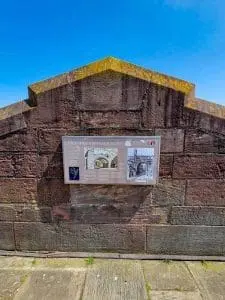 If you read the section above then you’ll know that Chester was a Roman fort, as such they needed a defensive structure to protect them from invading armies. They began construction of the city walls between 70 and 80 CE. The wall was originally made of earth, with a wooden palisade placed on top, but around 100 CE they began rebuilding the wall using sandstone and it took over 100 years to complete.
If you read the section above then you’ll know that Chester was a Roman fort, as such they needed a defensive structure to protect them from invading armies. They began construction of the city walls between 70 and 80 CE. The wall was originally made of earth, with a wooden palisade placed on top, but around 100 CE they began rebuilding the wall using sandstone and it took over 100 years to complete.
After the Normans invaded, the walls were extended along the west and south to form a complete circuit of the city.
The city walls of Chester have Grade I listed status and are some of the best preserved in the country. The walkway is a total of 2.95 kilometres or 1.8 miles and apart from a 100-metre section the walls are almost complete.
As we’ve already mentioned we started at the Little Roodee car park, so we’ll tell you about each section of the walls based on our journey round and the sights you can see along the way. You will find displays as you walk around the walls which will explain the history of each spot, so don’t worry too much if you forget what you read here.
Chester Castle Section
As you come out of the car park, you’ll see Chester Castle above, which is ran by the English Heritage. It was closed when we arrived and from what we can gather it’s only open at the weekend for prebooked guided tours. So, we recommend you check out the website and don’t do as we did and just turn up.
If you’re thinking about joining the English Heritage then check out our guide on ‘English Heritage Membership, Should You Bother’.
From the castle you can see the Grosvenor Bridge, which is an impressive stone arch bridge that crosses the river dee. When it was built in 1832 it was the longest single span stone bridge in the world and retained that title for 30 years. It is a Grade I listed building and quite an iconic bridge in Chester, due to its proximity to the castle.
There isn’t much of an obvious city wall along this area, so just follow the signs which will direct you to a set of steps and it’s here you’ll begin.
The Bridgegate
 Steps will lead you onto the Bridgegate and it’s here you will have the most spectacular view of the River Dee and the Old Dee Bridge. The gate guarded the southern entrance of the town and had the road from North Wales running directly to it. It’s estimated that this section of the Chester walls was built around the 1120’s, but it was rebuilt over the years to become the neoclassic arch which is present today.
Steps will lead you onto the Bridgegate and it’s here you will have the most spectacular view of the River Dee and the Old Dee Bridge. The gate guarded the southern entrance of the town and had the road from North Wales running directly to it. It’s estimated that this section of the Chester walls was built around the 1120’s, but it was rebuilt over the years to become the neoclassic arch which is present today.
As you continue walking along, you’ll pass a round tower which will have been used to watch invaders coming up the river. It has no internal rooms or doors and is simply a look out platform, but it provides some beautiful sights across the river Dee.
You’ll then reach the Recorder’s Steps which are two flights of stone steps which lead from the walkway to the riverside part of Chester known as the Groves. As you begin to head up to the Eastgate Clock there is another set of steps called the Wishing Steps which were constructed in 1785. There isn’t much attached to them history wise, and we cannot find any information on where the name came from, but they’re a great spot to stop and take in the views.
Chester Roman Gardens
On the corner is another prominent watch tower which was important for military defence, but it’s here you will see the Roman Gardens. They are located between the Newgate and the Amphitheatre, and the gardens are free to enter. But you can see them quite clearly if you’re walking the city walls, so you don’t have to specifically head down to go through.
The gardens are named after a collection of finely carved building fragments from the Roman legionary fortress of Deva. You will see sections of military buildings, which include the main baths and legionary headquarters.
The Nine Houses
As you head up to the clock tower you will see the Nine Houses, of which only six remain and they are in Park Street. These houses are designated as Grade II listed buildings, and they face the city walls. They were built in around 1650 and are the only surviving pre-19th century almshouses in Chester.
When you walk past the Nine Houses, you will see the site of a civil war breach which are holes from musket balls in the wall. The Siege of Chester took place during the English Civil War between February 1645 and January 1646 and was a fight between Parliamentary Forces and Royalists. It’s quite an interesting spot as you meander along the walls, but sadly many people miss it.
Newgate
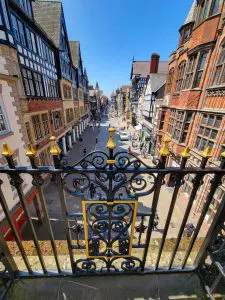 Newgate has a more modern look when you compare it to other bridges in Chester. This is because it was built in 1937/38 to relieve traffic congestion in the city. It is an arch bridge constructed in red sandstone and there is a flight of steps on each side which lead up to the towers and a walkway across the top of the bridge. You’ll find there’s a great view of one of the main streets in Chester called Pepper Street. The bridge is a Grade II listed building and its construction involved breaching a part of the city walls. Designed by Sir Walter Tapper, the bridge was given a medieval feel to match other areas of the walls, so you’ll see carved shields and Tudor roses.
Newgate has a more modern look when you compare it to other bridges in Chester. This is because it was built in 1937/38 to relieve traffic congestion in the city. It is an arch bridge constructed in red sandstone and there is a flight of steps on each side which lead up to the towers and a walkway across the top of the bridge. You’ll find there’s a great view of one of the main streets in Chester called Pepper Street. The bridge is a Grade II listed building and its construction involved breaching a part of the city walls. Designed by Sir Walter Tapper, the bridge was given a medieval feel to match other areas of the walls, so you’ll see carved shields and Tudor roses.
The wall slightly kinks just before Thimbley’s Tower and it is here you’ll see the predecessor of Newgate, which was called Wolfgate or Peppergate.
We loved this bridge because although it wasn’t as historic as other areas of the wall, it was incredibly pretty and provided amazing views all around.
Thimbley’s Tower / Wolf’s Tower
Right next to Newgate bridge is Thimbley’s Tower, which was formerly known as Wolf’s Tower. It was built in the 13th century, but partly demolished during the Civil War. This red sandstone tower is semi-octagonal and it has a steeply pitched gabled roof. As with the other towers it was built as a defence along the eastern section of the city.
Eastgate
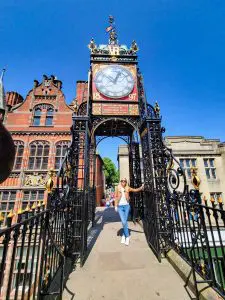 One of the most iconic symbols of Chester has to be the clock on Eastgate, which is the most photographed clock in England after Big Ben. Eastgate was the original entrance to the Roman fortress of Deva Victrix. The original gate was a timber tower but the present one is a three arched sandstone structure. In 1899 the beautiful ornate clock was added to the top of the gateway in celebration of the diamond jubilee of Queen Victoria. As with the rest of the Chester city walls, the whole structure including the gateway and clock is a Grade I listed building.
One of the most iconic symbols of Chester has to be the clock on Eastgate, which is the most photographed clock in England after Big Ben. Eastgate was the original entrance to the Roman fortress of Deva Victrix. The original gate was a timber tower but the present one is a three arched sandstone structure. In 1899 the beautiful ornate clock was added to the top of the gateway in celebration of the diamond jubilee of Queen Victoria. As with the rest of the Chester city walls, the whole structure including the gateway and clock is a Grade I listed building.
We loved the walk up to Eastgate because it felt like we turned a corner and suddenly there was the clock. Before you reach the actual bridge, you will notice there’s a little wall café so you could stop and grab a drink and sit outside as you take in the view. There are a few wall cafes dotted about which we loved, especially if you need a drink on a warm day.
Also, as we walked through, we saw someone dressed as a Roman centurion giving a talk on the local history. He didn’t seem to be charging, but we imagine you would be expected to give a tip at the end.
Chester Cathedral
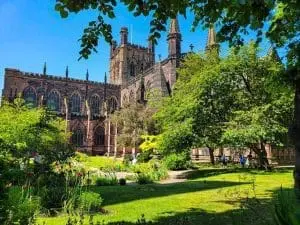 As you continue past Eastgate you will then come to the magnificent sight of Chester Cathedral. We have seen the Cathedral from the front before, but the view from the walls is pretty spectacular. Originally founded as a Benedictine abbey in 1092, the cathedral has a rich and varied history. You can enter for free, but donations are welcome, so if you have a chance, we definitely recommend popping in. Although the cathedral was a unique blend of medieval and modern history, it was originally built in a Romanesque or Norman style. From 1250 onwards it was rebuilt in a Gothic style which took 275 years and results in the structure seen today.
As you continue past Eastgate you will then come to the magnificent sight of Chester Cathedral. We have seen the Cathedral from the front before, but the view from the walls is pretty spectacular. Originally founded as a Benedictine abbey in 1092, the cathedral has a rich and varied history. You can enter for free, but donations are welcome, so if you have a chance, we definitely recommend popping in. Although the cathedral was a unique blend of medieval and modern history, it was originally built in a Romanesque or Norman style. From 1250 onwards it was rebuilt in a Gothic style which took 275 years and results in the structure seen today.
There is a Chester Cathedral Tower Tour where you’ll climb to the top of the central tower which is 125 feet tall. From the top you can see one city, two countries and five counties.
Kaleyards Gate
As you wander a little further on you will find a postern gate in the wall. It was created during the 13th century when the monks of St Werburgh’s Abbey needed an easier route through Eastgate, to access a vegetable garden they had developed called the Kaleyard, which was outside the city walls. They petitioned Edward I in 1275 for the gate and it was allowed under certain conditions, one of which was a requirement that it was locked at nightfall.
King Charles / Phoenix Tower
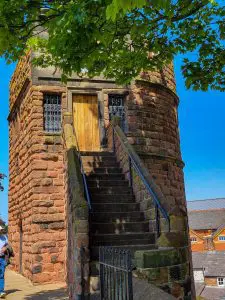 Of all the towers we saw as we walked the city walls, we found this one quite an impressive site. It was found on a corner and built within the 13th century. Over the years it was used in various ways, but there is a plaque on the tower which states that King Charles I stood on the tower on the 24th September 1645, watching his soldiers being defeated at the Battle of Rowton Heath, hence the name. During the Civil War the tower had a gun in each storey and was damaged in the conflict. The King Charles / Phoenix Tower is constructed in red sandstone, with a pyramidal slate roof and is around 70 feet high. It has four levels, with the walkway being on the third level and it is there you will see a round headed doorway. Above the doorway is a beautiful image of a phoenix on a plaque which is dated 1613. There is also a stairway which leads to the upper storey, but the doors there are closed.
Of all the towers we saw as we walked the city walls, we found this one quite an impressive site. It was found on a corner and built within the 13th century. Over the years it was used in various ways, but there is a plaque on the tower which states that King Charles I stood on the tower on the 24th September 1645, watching his soldiers being defeated at the Battle of Rowton Heath, hence the name. During the Civil War the tower had a gun in each storey and was damaged in the conflict. The King Charles / Phoenix Tower is constructed in red sandstone, with a pyramidal slate roof and is around 70 feet high. It has four levels, with the walkway being on the third level and it is there you will see a round headed doorway. Above the doorway is a beautiful image of a phoenix on a plaque which is dated 1613. There is also a stairway which leads to the upper storey, but the doors there are closed.
Northgate
Although Northgate isn’t as impressive as the others, it’s a great stop to enjoy views of the city and pop down for a drink or bite to eat. You’re not far from the front of Chester cathedral and the town hall if you’re incorporating other Chester sights into your visit.
This bridge stands on the original northern Roman entrance into Chester, but during the medieval period it was only used for local access. Alike the rest of the wall, the present Northgate was built in 1810 and is constructed in red sandstone with a segmental arch and a coffered soffit which spans the carriageway. At either side of the arch there is a rectangular opening specifically for pedestrians and they are attached to unfluted monolithic Doric half-columns. There’s a dentilled cornice across the top which carries a panelled parapet.
If you walk a little further on from Northgate, you will see the Bridge of Sighs over the Chester Canal. This is quite a historic bridge as it was built to allow condemned prisoners to receive the last rites before their execution, without the risk of escape.
Morgan’s Mount
As you continue to follow the walls along the beautiful canal, you will spot the unusual structure known as Morgan’s Mount. Constructed in 1645 during the Siege of Chester, Morgan’s Mount was an observation platform and gun placement. During the Battle of Rowton Heath it was destroyed by Parliamentary forces. The Mount consists of a chamber at walkway level, which has a barred opening towards the north and west. To reach the upper level there are two flights of five steps where you will find a stone parapet surmounted by iron railings. If you’re unsure if you’ve found Morgan’s Mount, simply look at the base of the tower and you should see a life-sized sculpture representing the cannon which was destroyed in the civil war.
St Martin’s Gate
We mention St Martin’s Gate because it is the newest gate in the city walls, having been constructed in 1966. It was built to ease the city’s traffic problems, but in all honesty this concrete bridge isn’t anything amazing to look at. St Martin’s, its namesake, was a small ancient parish church which stood close to the gate but was demolished to make way for a ring road.
Pemberton’s Parlour
Originally known as the Goblin Tower or Dille’s Tower, this structure originates as a circular tower which straddled the city walls and it was far higher than what stands there currently. It is red sandstone to go along with the rest of the wall and is a crenelated tower with an arch which leads to a semicircle chamber, with seating which faces the walkway of the walls. Above this are three panels, the lateral ones containing the royal arms, and the arms of Chester in relief.
During the reign of Queen Anne it was rebuilt, and then again in late Victorian times (1894). Its name is said to derive from John Pemburton who was a former mayor of Chester and who stood on it to supervise the work taking place on his nearby ropewalk.
Bonewaldesthorne’s Tower and The Water Tower
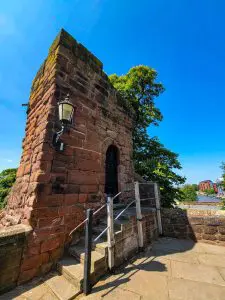 As we head into the last section of the wall, you’ll come across a medieval structure on the northwest of the city walls. Alike the other towers it was built and used as part of the cities defensive system. We enjoyed this section of the wall as it was quite beautiful and leads onto the Water Tower.
As we head into the last section of the wall, you’ll come across a medieval structure on the northwest of the city walls. Alike the other towers it was built and used as part of the cities defensive system. We enjoyed this section of the wall as it was quite beautiful and leads onto the Water Tower.
The tower is rectangular and stands on a tall plinth, with seven steps leading up from the walkway on the city walls to an arched doorway. On the other side of the doorway, you’ll find the spur wall to the Water Tower. The top of the tower is battlemented, and on the inside, there is a fireplace and closed staircase which is lit by a single slit window. Although the tower appears in documents since 1249, it was rebuilt or altered in 1322-26 when it became a gatehouse to the Water Tower.
The Water Tower was originally known as the New Tower and was constructed in the 14th century. Both towers and the spur wall are recorded as Grade I listed buildings. The main purpose of the tower was to defend the city of Chester, but it was also used to monitor movements of shipping to ensure custom dues were paid. By the end of the 16th century the river had silted up and the tower was landlocked. It was renovated in 1639 and the embrasures in the spur wall were made into gun ports. The tower was attacked and damaged during the Civil War, but from 1671 it was leased as a storehouse.
The design of the tower is circular at its base with a square turret above, in two stages containing octagonal chambers, one above the other. It’s around 75 feet and there is an archway in the city walls which lead down to 44 stone steps on the way down to the tower. Alike Bonewaldesthorne’s Tower the wall is crenelated.
The rest of the walk is quite sparse when it comes to towers or gates, but there’s still plenty to take in as you head towards Chester Racecourse. This includes the Watergate which was built between 1788 and 1790 as a pedestrian path over a road.
As you walk along Chester Racecourse you will see the Architect pub, we stopped in for some food and it was lovely, especially on a warm summer’s day. This will take you back to the crossing for the car park, and you can then head in and explore a little more of what beautiful Chester has to offer.
Would we recommend Chester city walls? That’s a resounding yes! We’re huge fans of Chester for the nightlife and shopping, but we’ve never really thought about heading in and looking at the history, which seems crazy for a place steeped in it. This was our first foray into Chester’s history, and we know we will walk the walls again and delve a little deeper by visiting the cathedral and Chester castle. The best part of this bucket list item is that it is completely free and perfect for a warm dry day.
If you do visit Chester City Walls then please tag us into your Instagram posts, because we love to see what our readers are up to as they tick off their bucket lists.